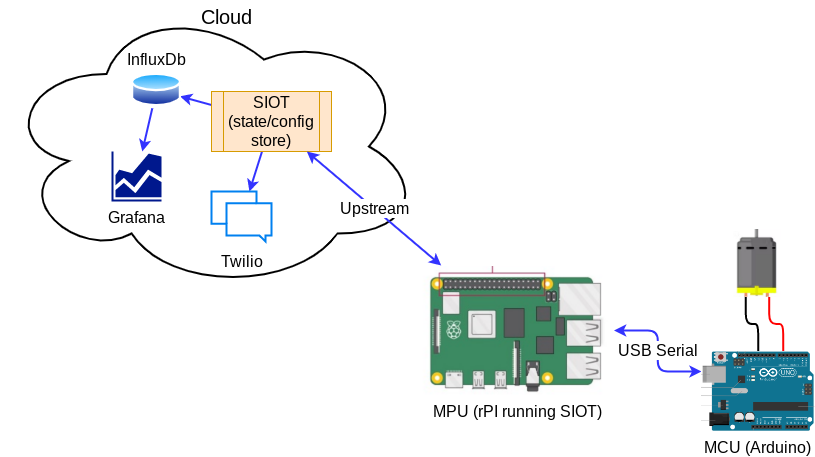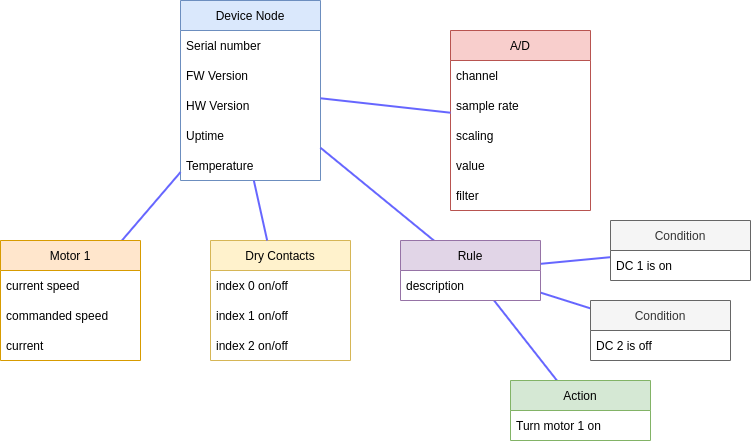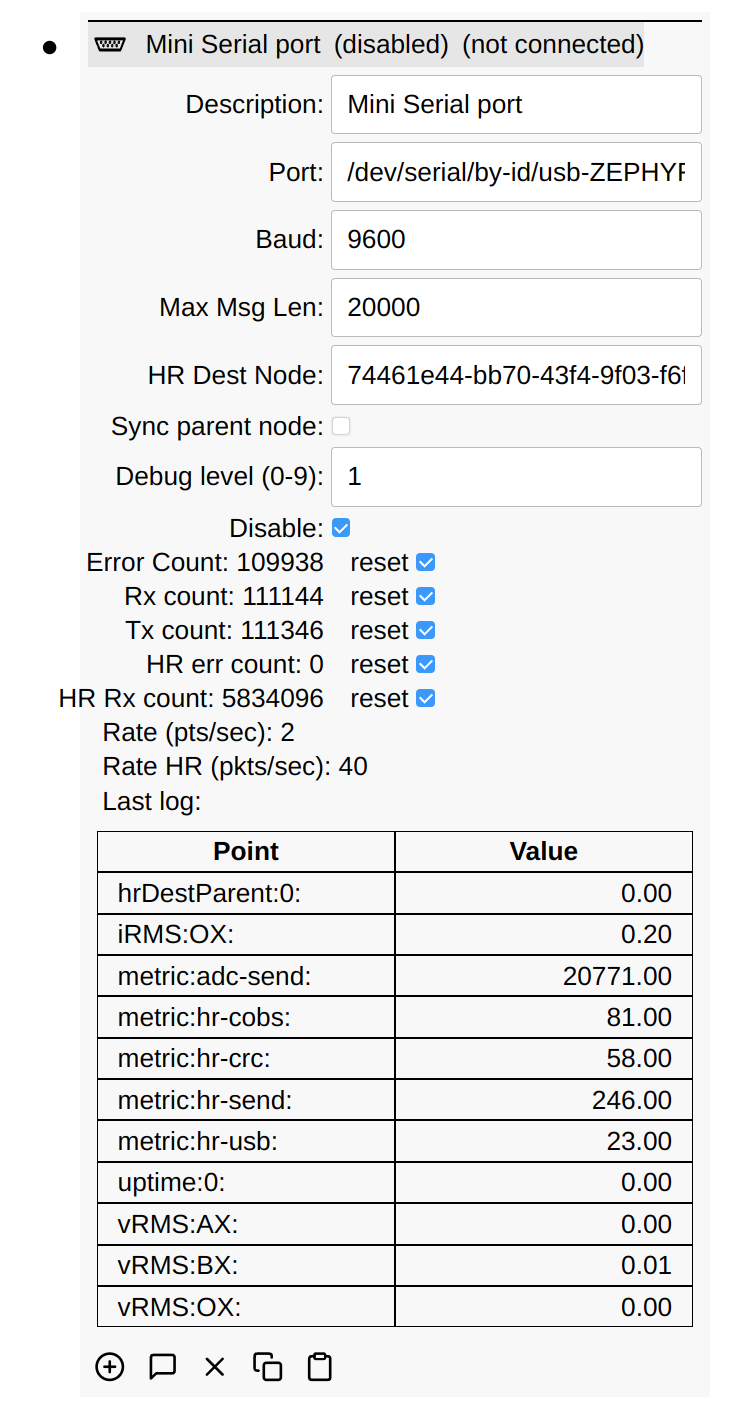Serial Devices
Contents
(see also user documentation and SIOT Firmware)
It is common in embedded systems architectures for an MPU (Linux-based running SIOT) to be connected via a serial link (RS232, RS485, CAN, USB serial) to an MCU.

See this article for a discussion on the differences between an MPU and MCU. These devices are not connected via a network interface, so can’t use the SIOT NATS API directly, thus we need to define a proxy between the serial interface and NATS for the MCU to interact with the SIOT system.
State/config data in both the MCU and MPU systems are represented as nodes and points. An example of nodes and points is shown below. These can be arranged in any structure that makes sense and is convenient. Simple devices may only have a single node with a handful of points.

SIOT does not differentiate between state (ex: sensor values) and config (ex: pump turn-on delay) - it is all points. This simplifies the transport and allows changes to be made in multiple places. It also allows for the granular transmission and synchronization of data - we don’t need to send the entire state/config anytime something changes.
SIOT has the ability to log points to InfluxDB, so this mechanism can also be used to log messages, events, state changes, whatever - simply use an existing point type or define a new one, and send it upstream.
Data Synchronization
By default, the serial client synchronizes any extra points written to the serial node. The serial UI displays the extra points as shown below:

Alternatively, there is an option for the serial client to sync its parent’s points to the serial device. When this is selected, any points received from the serial device are posted to the parent node, and any points posted to the parent node that were not sent by the serial device are forwarded to the serial client.
Protocol
The SIOT serial protocol mirrors the NATS PUB message with a few assumptions:
- We don’t have mirrored nodes inside the MCU device
- The number of nodes and points in an MCU is relatively small
- The payload is always an array of points
- Only the following SIOT NATS API subjects are supported:
- Blank (assumes ID of Serial MCU client node
p.<id>(used to send node points)p.<id>.<parent>(used to send edge points)phr(specifies high-rate payload)
- We don’t support NATS subscriptions or requests - on startup, we send the entire dataset for the MCU device in both directions (see On connection section), merge the contents, and then assume any changes will get sent and received after that.
subject can be left blank when sending/receiving points for the MCU root node.
This saves some data in the serial messages.
The point type nodeType is used to create new nodes and to send the node type
on connection.
All packets are ack’d (in both directions) by an empty packet with the same sequence number and subject set to ‘ack’. If an ack is not received in X amount of time, the packet is retried up to 3 times, and then the other device is considered “offline”.
Encoding
Packet Frame
All packets between the SIOT and serial MCU systems are framed as follows:
sequence (1 byte, rolls over)
subject (16 bytes)
payload (Protobuf Point array or HR repeated point payload)
crc (2 bytes) (Currently using CRC-16/KERMIT) (not included on log messages)
Protocols like RS232 and USB serial do not have any inherent framing; therefore, this needs to be done at the application level. SIOT encodes each packet using COBS (Consistent Overhead Byte Stuffing).
Log payload
The log message is specified with log in the packet frame subject. The payload
is ASCII characters and CRC not included.
Protobuf payload
The serial Protobuf type is used to transfer these messages:
message SerialPoint {
string type = 2;
float value = 4;
int64 time = 16;
float index = 13;
string text = 8;
string key = 11;
int32 tombstone = 12;
}
Protobuf can be used for low-rate samples, config, state, etc.
Protobuf is used to encode the data on the wire. Find Protobuf files here. Nanopb can be used to generate C-based Protobuf bindings that are suitable for use in most MCU environments.
High-rate payload
A simple payload encoding for high-rate data can be used to avoid the overhead
of Protobuf encoding and is specified with phr in the packet frame subject.
type (16 bytes) point type
key (16 bytes) point key
starttime (uint64) starting time of samples in ns since Unix Epoch
sampleperiod (uint32) time between samples in ns
data (variable, remainder of packet), packed 32-bit floating point samples
This data bypasses most of the processing in SIOT and is sent to a special
phr NATS subject. Clients that are interested in high-rate data
(like the InfluxDB client) can listen to these subjects.
File payload
This payload type is for transferring files in blocks. These files may be used for firmware updates or other transfers where large amounts of data need to be transferred. An empty block with index set to -1 is sent at the end of the transfer.
name (16 bytes) filename
index (4 bytes) file block index
data (variable, remainder of packet)
On connection
On initial connection between a serial device and SIOT, the following steps are done:
- The MCU sends the SIOT system an empty packet with its root node ID
- The SIOT systems sends the current time to the MCU (point type
currentTime) - The MCU updates any “offline” points with the current time (see offline section).
- The SIOT acks the current time packet.
- All the node and edge points are sent from the SIOT system to the MCU, and
from the MCU to the SIOT system. Each system compares point time stamps and
updates any points that are newer. Relationships between nodes are defined by
edge points (point type
tombstone).
Timestamps
The Simple IoT uses a 64-bit nanosecond since Unit epoch value for all timestamps.
Fault handling
Any communication medium has the potential to be disrupted (unplugged/damaged wires, one side off, etc.). Devices should continue to operate and when re-connected, do the right thing.
If an MCU has a valid time (RTC, sync from SIOT, etc.), it will continue operating, and when reconnected, it will send all its points to re-sync.
If an MCU powers up and has no time, it will set the time to 1970 and start operating. When it receives a valid time from the SIOT system, it will compute the time offset from the SIOT time and its own 1970 based time. It then indexes through all points and adds the offset to any points with time less than 2020, and then send all points to SIOT.
When the MCU syncs time with SIOT, if the MCU time is ahead of the SIOT system, then it set its time, and look for any points with a time after present, and reset these timestamps to the present.
RS485
Status: Idea
RS485 is a half duplex, prompt response transport. SIOT periodically prompts MCU devices for new data at some configurable rate. Data is still COBS encoded so that is simple to tell where packets start/stop without needing to rely on dead space on the line.
Simple IoT also supports Modbus, but the native SIOT protocol is more capable - especially for structured data.
Addressing: TODO
CAN
Status: Idea
CAN messages are limited to 8 bytes. The J1939 Transport Protocol can be used to assemble multiple messages into a larger packet for transferring up to 1785 bytes.
Implementation notes
Both the SIOT and MCU side need to store the common set of nodes and points
between the systems. This is critical as the point merge algorithm only uses an
incoming point if the incoming point is newer than the one currently stored on
the device. For SIOT NATS clients, we use the NodeEdge data structure:
type NodeEdge struct {
ID string
Type string
Parent string
Points Points
EdgePoints Points
Origin string
}
Something similar could be done on the MCU.
If new nodes are created on the MCU, the ID must be an UUID, so that it does not conflict with any of the node IDs in the upstream SIOT system(s).
On the SIOT side, we keep a list of Nodes on the MCU and periodically check if any new Nodes have been created. If so, we send the new Nodes to the MCU. Subscriptions are set up for points and edges of all nodes, and any new points are sent to the MCU. Any points received from the MCU simply forwarded to the SIOT NATS bus.
DFU
Status: Idea
For devices that support USB Device Firmware Upgrade (DFU), SIOT provides a mechanism to do these updates. A node that specifies USB ID and file configures the process.